Revell 1/72 scale
Mc Donnell Douglas F-4F
Phantom II
by Fernando Rolandelli
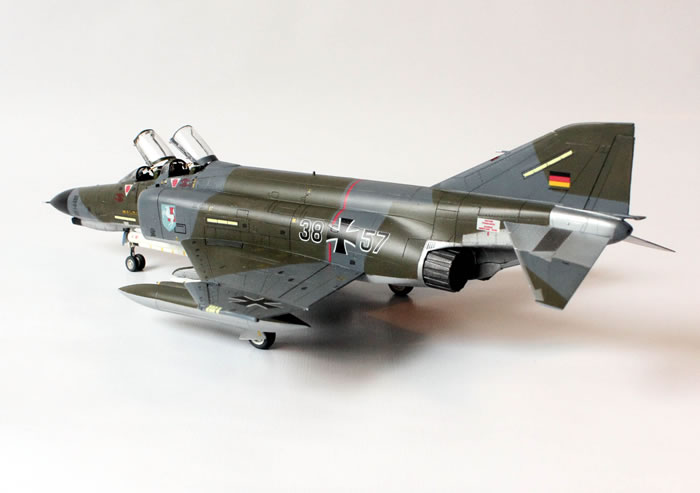 |
Mc Donnell Douglas F-4F-59-MC Phantom II
38+57 (72-1166) Jagdbomber Geschwader 36 „Westfalen“, Bundesluftwaffe, 1977 |

Revell's 1/72 scale F-4F Phantom II is available online from Squadron for only $19.96!
Background
When the Flexible Response doctrine came into vogue in NATO in the late 1960s, it was not longer enough to simply toss nuclear warheads on the Soviets as soon as they crossed the border; old-style, conventional warfare was called upon. Therefore, the Bundesluftwaffe found that it needed a plane that could fly and fight; Starfighters´ ability to perform such activities being marginal at best.
Not surprisingly given the timeframe, the chosen one was the F-4 Phantom II.
Though the base variant was the combat-slatted wing F-4E, it was customized for the Germans, though in a less dramatic way than, say, the Brits did with theirs. AIM-7 Sparrow capability was deleted, leaving the big machine relying on its internal gun and first-generation IR missiles (AIM-9B) for air combat; and mostly free-falling “unguided” bombs aimed basically visually for air to ground attack. The seventh internal fuel tank added to the F-4E was deleted (though the IFR capability was not, as has sometimes been reported). Finally, to keep a greater degree of uniformity with the RF-4E fleet, as well as a cost and weight reducing measure, non-slatted tailplanes were ordered.
The final result was a rather lighter Phantom, with better manoeuvrability than a standard F-4E (not to speak about a hard-wing FGR.2); however, these big machines would have had no choice but engaging in turning dogfights against nimbler Soviet fighters trying to get a shot from astern for their gun (with an extremely short firing time) or Sidewinders.
Two air defense units, JagdGeschwader 71 “Richthofen”, and 74 “Mölders”, plus two ground attack, JBG 35 (later JG 73 “Steinhoff”) and JBG 36 “Westphalen” (later JG 72 and still later “Fluglehrzentrum F-4F”, until disbanded at Rhein-Hopsten in 2006) were created, plus several test units. Total procurement was 175 machines. The planes went through two upgrading programmes called “Peace Rhine” (the first one from 1980 to 1984; the second from 1990 to 1997), the last one putting the aircraft on par to the latest Phantoms around.
The Kit
Being deployed to Germany, it was natural for me to start a series on Bundesluftwaffe aircraft, using the local Revell kits, both cheap and generally available.
Unfortunately, the current boxings of Tornado and Phantom kits invariably show commemorative schemes, which I find cheesy and unattractive. The Phantom kit I got was in a farewell scheme of Blue and Gold, and was therefore molded in a bright Blue that kept creeping under the paint.
Mainstream decals for operative German Phantoms are surprisingly scarce: the best sets are those of the AirDoc series, unfortunately unavailable by now; after some research, I came upon some cottage industry decal manufacturers, like Ha Hen in the UK and Peddinghaus here in Germany, whose decal sheets I intend to give a try soon.
A fancy scheme also mean that there are no stencils to speak of, and jet planes are like flying books; therefore some modern decal sheets, like Model Alliance, are useless, for they provide only the specific insignia. I managed to grab an old Modeldecal sheet, which included a Phantom in the old Norm 72 camouflage, with almost complete stencils.
To dress up the rather bare cockpit I got an Aires set; experience with it was less than happy to say the least.
The “piece de resistence” of the whole assembly was coercing the Aires interior into the nose of the kit. Revell kits have the most slender nose of them all (Hasegawa´s being wider and Fujimi/Esci even wider), which didn´t help.
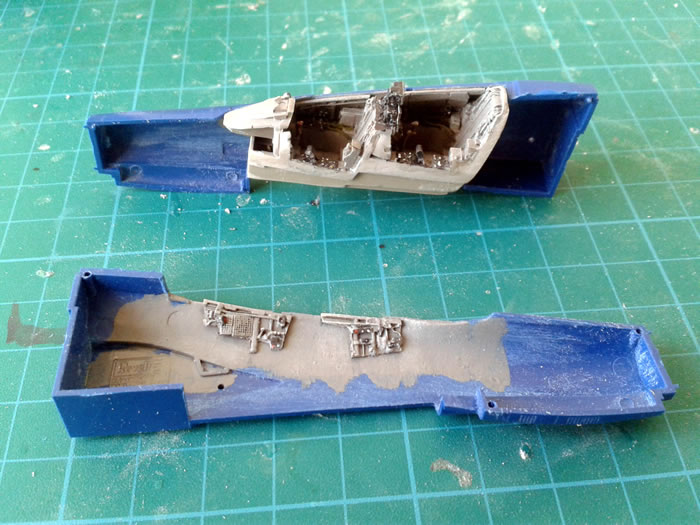
I thinned the resin sidewalls to become translucent, but they still didn´t fit; in the end I resorted to cutting off the detail and gluing it straight to the kit´s sidewalls. It worked. The bathtub fitted better, though it ended up a bit crooked to the left; I resorted to some painting magic to hide that.
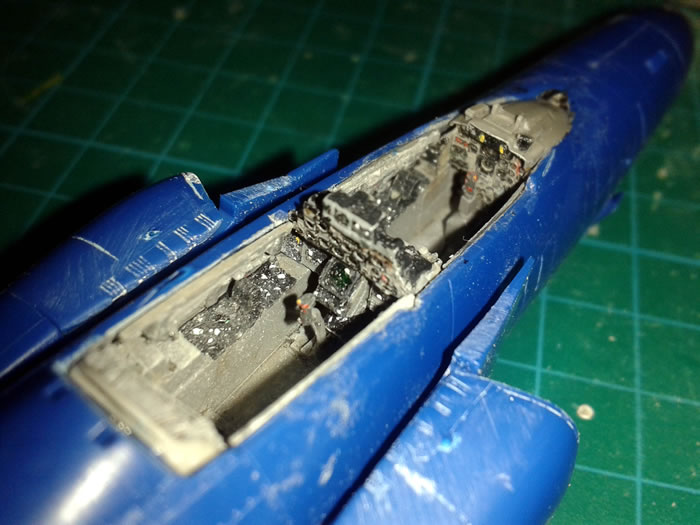
A source of grief was the recurring bane of all Phantom kits (and indeed of any jet aircraft): the intake ducting. Revell provided an internal bulkhead with the turbine faces moulded in, but nothing else; I filled the cavity visible in the lower wing with Milliput, once everything was in place, and molding it wet before it settled; the gluing step for the covers was also deleted, but did not harm their fit. Then, a light sanding provided an acceptable if a bit untidy look. Another usual problem with Phantom kits, the angle of the outer wing sections, had no easy solution either, and in fact I had to snap one off and reattach it during the final assembly.
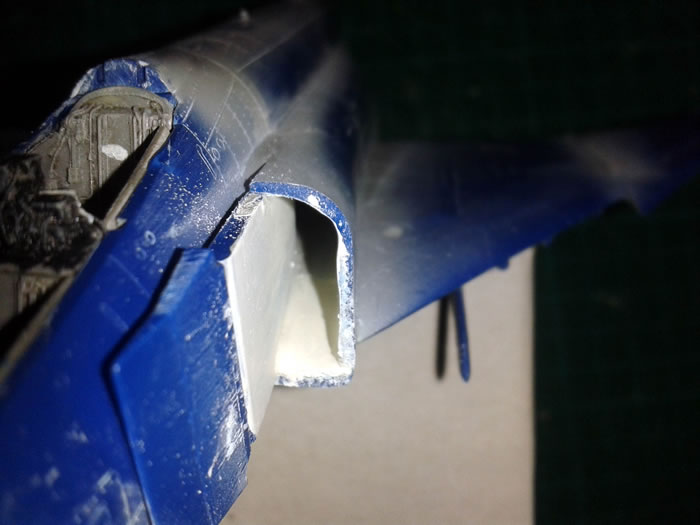
To compensate, the fit of the forward fuselage to the rear section proved exemplary, as well as the intakes themselves and the lower wing to fuselage; on the whole, very little putty was required, even in the long spine and nose. Even usually troublesome parts like undercarriage legs and covers, and the heavily angled tailplanes, had a very positive fit. An exception should be called on the front leg, which, if butted safely against the roof of the well, would render a marked “nose down” attitude to the model. I glued it midways; it is probably “too long”, but the sit of the model improves considerably. Wheels are “weighted”, but posed on problems to fit correctly.
Backdating the kit included sealing the slots for the AIM-120 and erasing the ALE-40 chaff dispensers on the inner pylons; lacking the proper Royal Jet centreline fuel tank (the kit provides the later HPC F-15-style one), I also blanked off the central pylon. I also suspect that the Sidewinder cheek launchers are the later LAU-7 instead of the correct (for the period) Aero-3b, but the difference I think would be academic in modelling terms. Airframe detailing included dressing up the wheel wells and the interior of the exhaust by the customary little plastic squares and cables the former and the Tamiya tape “petals” the latter.
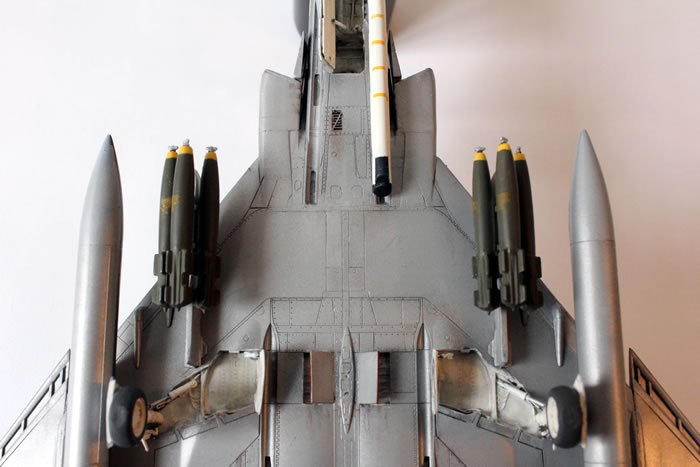
The armament included in the kit is good, but appropriate for an ICE Phantom. JaBo 36 having a primary ground attack role, with secondary air-defence, it gave the chance of a bombed up Phantom, so I looked for a suitable load: four/six BL-755 would have been most attractive, but I failed to get more than a couple (from a Hase F-16 kit); Matra 25D bombs are virtually unknown in model form, at least in this scale; so I settled for six Mk.82 “Snakeye”, another load mentioned as common, sourcing them from an ubiquitous Hasegawa set. The provided ALQ-119(V) was backdated into an -101(V), including some spurious little stencils.
Painting
Early in their life, German Phantoms were painted in the so-called Norm 72 scheme, inherited from that of the Starfighters. It involved a very German-looking splinter pattern upper surfaces in RAL 7012 Basaltgrau and RAL 6014 Gelbolive; lowers in 9006 Silbergrau. I used Xtracrylix paints through and through. Basaltgrau has a slightly bluish tinge, more visible in some pictures than in others; I used FS36118.
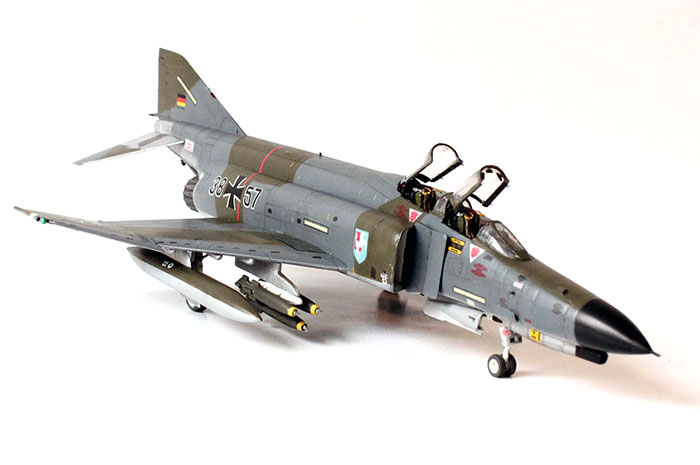
Gelbolive has a distinctive brownish tone; I used ANA 613 Olive Drab. For the Silbergrau, I made a mix of about 60-40% of Silver and FS36473 ADC Gray; the contrast to the true NMF parts, painted in Alclad Aluminium, looks satisfactory.
The metallic exhaust area typical of Phantoms I always paint in several shades of Alclad: an Aluminium base, Titanium lower part and Burnt Metal exhausts. These I finished in a Silver dry brushing and a rubbing in graphite powder.
German planes of the period are invariably pristine, so I went light with weathering: the usual preshading and mottle-painting was enough for paint fading and unevenness, and some oils and pastels finished the work.
Decals
Modeldecals is an old brand; the sheets have been stocked for years at Hannants. They come in a yellowish paper which doesn´t exactly inspire confidence. Instructions are drawn in the old style; however, they are pretty comprehensive, and show a remarkable research, usually depicting individual airframes seen at air shows or “open days”; they are a prime source of “vintage” schemes of the seventies and eighties.
This airframe was seen at Rhein-Hopsten in 1977, having some non-standard stencilling perfectly captured in the decals; Nordrhein/Westfalen being the region I live in, it was most appropriate, even including the White prancing stallion in the medieval coat of arms.
They performed flawlessly, with not a hint of silvering, though they are just a bit on the thick side.
Stenciling is rather complete (at least for the upper surfaces!), with the single exception of the characteristic walkway area, which I took from a stencil sheet, painting the Grey area in FS36081. On close examination, the crosses seem a bit large and the numbers a bit short (and the White slightly misaligned); I should have placed them a little higher on the fuselage´s sides for a better look.
I also used some ProModeller formation lights, superimposed on the Modeldecal ones; do not get the fuselage and nose ones confused.
The Phantom is surely one of the most kitted planes ever.
First-generation kits, like the Frog, antique Hasegawa and Revell-Lodela are primitive kits from the seventies; second generation like Esci/Italeri and Fujimi are good kits respectable even today; current generation, Hasegawa and Revell are certainly state-of-the-art kits; we shall see what the new Academy brings on.
Revell kits are keyed specifically to German F-4F ICE: that´s apparent in the armament and especially in the non-slatted tailplane, limiting the options; that´s a shame, for they even come with a hard-wing outer section (left over from the RF kit); had they provided it with a spare slatted tailplane, they would have sold this little kit like hot cakes.
That said, Revell kits have a couple of shape problems: the canopy contour looks a bit shallow, the tip of the fin too canted and the sit of the model is a bit “nose down”. However, they are good, honest, well detailed kits that render a nice model OOB, and can be improved a bit at the cost of some work.
References
- Air Doc No. 06 (and 07) Luftwaffe Phantoms Part 1 (and 2) - Andreas Klein 2004
- Bundesluftwaffe Intern - Heinz von Knobloch - Motorbuch Verlag 2008
- Detail and Scale 007 - F-4 Phantom part 2 - F-4E/G In detail and scale - Bert Kinzey
- Air Vanguard 007 - USAF Mc Donnell Douglas Phantom II - Peter Davies - Osprey publishing
- Squadron In Action n° 65 - Squadron Signal publications
Model, Images and Text
Copyright ©
2015 by Fernando Rolandelli
Page Created 16 August, 2015
Last Updated
16 August, 2015
Back to HyperScale Main Page
|
Home
| What's New | Features | Gallery | Reviews | Reference | Resource Guides | Forum |